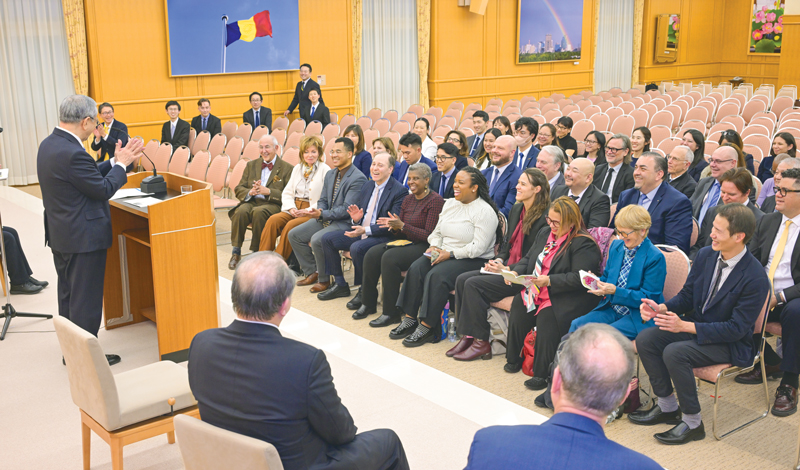SGI-USA training course participants attended a gongyo meeting with Soka Gakkai President Minoru Harada at the Soka Gakkai Headquarters in Tokyo, on Jan. 22, 2025. SGI General Director Yoshiki Tanigawa and SGI Women’s Leader Yumiko Kasanuki were also in attendance. President Harada’s excerpted address follows.
First, I would like to express my deepest condolences to all those affected by the Los Angeles wildfires. As we did gongyo and daimoku, I chanted for the well-being of everyone affected by the disaster. I heard that some of the leaders who were supposed to be participants in this training course remained behind to encourage the members. I would like to offer my heartfelt gratitude for your selfless efforts. The members in Japan are chanting for the fastest possible recovery and reconstruction of the affected areas.
Today, I would like to touch upon some of the history between Ikeda Sensei and the former U.S. Secretary of State Henry Kissinger to provide some context to your significant travels to celebrate the 50th anniversary of the SGI’s founding on Guam, on Jan. 26, 1975. These events are recorded in volume 20 of The New Human Revolution.
Sensei met with Dr. Kissinger in January 1975. Right before their encounter, he asked youth division members in Los Angeles: “What kind of stance should I take when I meet with [him]? Should I go as the leader of a peace, culture and education movement or should I go as the founder of Soka University?”
After hearing all their voices, he said: “OK, I’m going with the stance: ‘I am the Soka Gakkai.’”
Actually, in 1973, Sensei had sent a letter to U.S. President Richard Nixon via Dr. Kissinger, laying out concrete steps toward achieving peace in Vietnam. Sensei and Dr. Kissinger exchanged correspondence several times after that. Then, Dr. Kissinger invited Sensei to meet when he came to the U.S. That meeting was realized on Jan. 13, 1975.
When Sensei and Dr. Kissinger met that day, Dr. Kissinger asked point blank: “Where does your allegiance lie with regard to the world powers?” (NHR-20, 323). Dr. Kissinger asked this question because he knew that Sensei had traveled to China and Russia the previous year; he wanted to understand what his intentions were.
Sensei responded: “We are not affiliated with the Western or the Eastern bloc. Nor are we the allies of China, the Soviet Union or the United States. We are a force for peace, and we ally ourselves with humankind” (NHR-20, 323).
His fundamental position was that of humanism. When Sensei responded in that way, he thought that he saw Dr. Kissinger smile. He seemed to have understood Sensei’s convictions. I think Dr. Kissinger must have felt relieved.
The second matter they discussed was the conflict in the Middle East. Sensei foresaw that they would be discussing this very important issue, so he had prepared a 10-page proposal and had it translated into English to present to Dr. Kissinger. Again, the details of this proposal are in The New Human Revolution, but I want to relay its three main points:
1) “The opinions of the people of the weaker nations must be given priority over the interests of the powerful nations” (NHR-20, 324).
2) “Patient and steady negotiation, not force of arms, represented the only way to peace” (NHR-20, 325).
3) “Specific negotiations aimed at creating a peaceful resolution should take place among the primary parties involved in the conflict” (NHR-20, 326).
Sensei wrote at the end of the proposal that he hoped it “would be accepted as the heartfelt expression of a friend who eagerly desires peace for all humanity” (NHR-20, 326).
When Sensei presented this proposal, Dr. Kissinger surprisingly read it three times on the spot. Afterward, he said: “Please give me a few days to consider what you have written here. And next time, I hope you will also make suggestions concerning the problem of oil. I also promise to convey your ideas to the president” (NHR-20, 327).
From then on, Sensei and Dr. Kissinger met another seven times. The dialogue of their 1986 visit was published the following year as Heiwa to jinsei to tetsugaku wo kataru (Dialogue on Peace, Life, and Philosophy). In September 1987, Dr. Kissinger attended a youth peace festival at Soka University.
Their 8th and final meeting took place on June 17, 1996. Actually, that February, Cuban fighter jets had shot down two U.S. civilian planes, leading to a significant increase in bilateral tensions.
Dr. Kissinger found out that Sensei would be visiting Cuba. When Sensei was in New York, Dr. Kissinger came to meet with him, hoping Sensei could play a role in softening tensions between the U.S. and Cuba. After that, Sensei visited Cuba and met with its leader, Fidel Castro. They talked about many topics, including politics, philosophy, raising capable people and their favorite authors.
And, of course, Sensei conveyed Dr. Kissinger’s message to Mr. Castro. Subsequently, U.S.-Cuba tensions eased.
There’s one more episode that I wish to share with you. In July 2002, the Baseball Hall of Fame induction ceremony was held [in Cooperstown, N.Y.]. Orlando Cepeda, an SGI member, spoke as a representative of the baseball Hall of Fame inductees. On that occasion, he said: “Encountering SGI President Ikeda has fundamentally changed the course of my life. He gave me what’s most important for a human to live, and that is hope.”
Dr. Kissinger, who was also in attendance, remarked: “I know President Ikeda very well. He is a Buddhist philosopher and one of my dearest friends. Dr. Ikeda is an outstanding individual, peace activist and leader of ordinary people.”
I wanted to share the battle that Sensei undertook exactly 50 years ago with you, who will be celebrating the 50th anniversary of the SGI’s founding on Guam.
It’s been 50 years since Sensei commenced his intense struggles for peace; it is now our turn as his disciples to convey his peace philosophy throughout the world and embody it in our daily lives.
Setting our sights on the Soka Gakkai’s centennial—this year is the 95th anniversary—and the next 50 years of the SGI, please continue to advance in solid unity, centering on your general director, Adin Strauss, and please continue to win victory after victory in this year of Soaring Higher Toward a Youthful Soka Gakkai Worldwide.
You are reading {{ meterCount }} of {{ meterMax }} free premium articles

